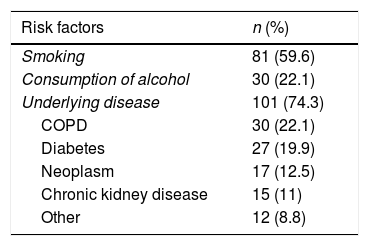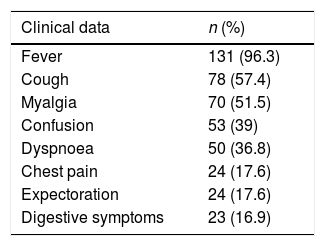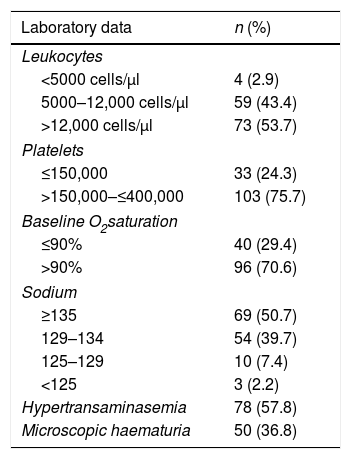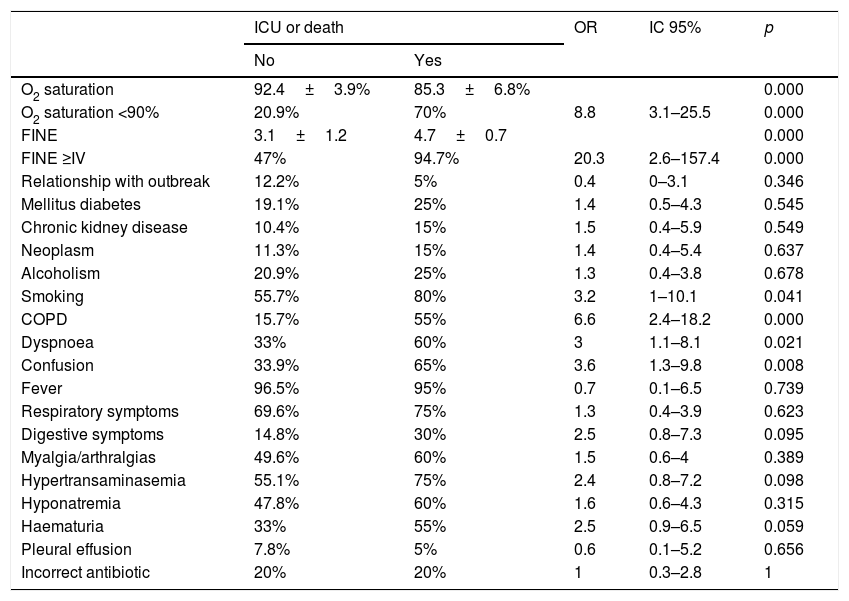Most of the data on Legionella pneumonia in our country come from the Mediterranean area, and there are few studies from the Northwest area. This study tries to assess the situation of this infection in this area.
MethodRetrospective study of all patients with positive Legionella antigenuria treated at the University Hospital Lucus Augusti in Lugo (Spain) from 2001, the year in which this test was introduced in our centre, until 2015. We analysed epidemiological data, risk factors, clinical, radiological and biochemical findings, and clinical outcome.
ResultsThe sampled included 136 patients. When comparing the first five years of the study with the last five, the incidence increased from 10.9 to 64.5 cases/1,000,000; the number of antigenuria requests increased 3.4 times, and compared to other pneumonia aetiologies Legionella increased from 0.9% to 15%. The mean age was 64.1 years and 84.6% were males; 74.3% had comorbidities. Males were significantly younger (62.7±16.6 vs. 71.9±17.3) and consumed more alcohol (26.1% vs. 0%) and tobacco (67.8% vs. 14.3%). Diagnosis was established within the first 72h in 88.9% of cases and most received levofloxacin (95.6%). Hospitalisation was needed in 85% of cases, 11.7% in ICU and 4.4% died.
ConclusionsAfter the introduction of antigenuria there was an increase in the incidence of Legionella pneumonia recorded in our health area. Its rate in recent years has been one of the highest in our country. Despite the fact that the patients had advanced age and comorbidities, mortality was low.
La mayoría de los datos de la neumonía por Legionella en nuestro país proceden del área mediterránea, y apenas existen estudios en la zona del Noroeste. Con este trabajo se pretende conocer la situación de la infección en nuestro medio.
MétodoEstudio retrospectivo de todos los pacientes con antigenuria positiva para Legionella en el Hospital Universitario Lucus Augusti de Lugo desde 2001, año en que se introdujo la antigenuria como prueba diagnóstica en nuestro centro, hasta 2015. Se analizaron datos epidemiológicos, factores de riesgo, hallazgos clínicos, radiológicos, analíticos y evolutivos.
ResultadosSe registraron 136 pacientes. Si comparamos los primeros 5 años del estudio con los 5últimos, la incidencia aumentó de 10,9 a 64,5 casos/1.000.000, el número de peticiones de antigenuria se incrementó 3,4 veces, y con respecto a otras neumonías, Legionella pasó del 0,9 al 15% de ellas. La edad media fue de 64,1años, y el 84,6% fueron varones. El 74,3% tenían comorbilidades. Los varones fueron significativamente más jóvenes (62,7±16,6 vs 71,9±17,3) y consumían más alcohol (26,1% vs 0%) y tabaco (67,8% vs 14,3%). El 88,9% se diagnosticaron dentro de las primeras 72h y la mayoría recibió levofloxacino (95,6%). El 85% necesitaron ingreso hospitalario, el 11,7% en UCI y el 4,4% fallecieron.
ConclusionesCoincidiendo con la introducción de la antigenuria, se observa un aumento de incidencia de neumonía por Legionella en nuestra área sanitaria, con tasas en los últimos años que se sitúan entre las más altas de nuestro país. A pesar de tener pacientes con elevada edad media y un alto porcentaje de comorbilidades, la mortalidad fue reducida.
Artículo
Comprando el artículo el PDF del mismo podrá ser descargado
Precio 19,34 €
Comprar ahora











